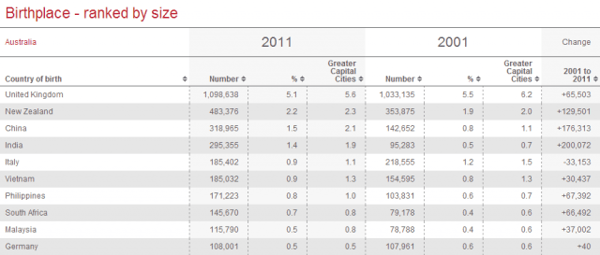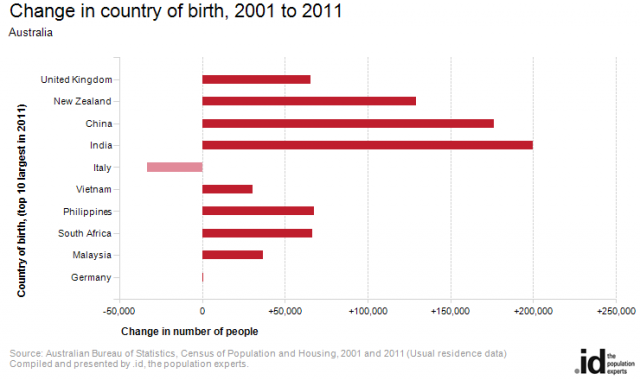The .id Australian Community Profile site makes it easy to analyse census data, in this blog I explore changes to the numbers and settlement patterns of Australian residents born overseas…
.jpg?width=300&height=200&name=Australia-online-pic%20(1).jpg)
I recently attended the Australian Population Association’s biennial conference, what a great, informative, and inspiring 3 days! James Newell’s presentation on Kiwis in Australia was one of many highlights for me. Now that I’m back in the office I thought I’d use the newly updated profile .id tool to explore changes to the numbers and settlement patterns of Australian residents born overseas, including New Zealanders.
Previously published blogs on this topic include, 2011 Census – Where are the most multicultural communities, and Australia’s migrants – who are they and how are they changing?.
What is the Australia Community Profile?
.id has developed the Australian Community Profile to assist our clients in viewing and understanding Australian census data. The Australia Community Profile provides demographic analysis for numerous geographic areas within Australia based on results from the 2011, 2006, 2001, 1996 and 1991 Censuses of Population and Housing. The length of time series depends in part on how data were classified and processed by the Australian Bureau of Statistics (ABS), and also whether you are looking at the enumerated population (who was here on census night, so includes visitors from overseas) or the usually resident population.
How does country of birth data help us understand Australia’s cultural diversity?
Country of birth data identifies where people were born and is indicative of the level of cultural diversity in Australia. The mix of country of birth groups is also indicative of historical settlement patterns, as source countries for Australia’s immigration program have varied significantly over time. To get a more complete picture of cultural and ethnic characteristics, the Australia’s country of birth data should be viewed together with ancestry, language spoken at home, and religion. Keep an eye out for future blogs on these topics.
Where are the most overseas born Australian residents born? … and where do they live within Australia?
As a recent addition to the .id family, and new to the community profile site, I was relieved to find the profile .id site very straight-forward to access and navigate. Looking through the usual resident data within the ‘Who are we?’ section and comparing the results from the 2001 and 2011 Censuses, I could immediately see that within Australia the most common country of birth (other than Australia) was the United Kingdom (UK). While the number and percentage of UK born Australian residents were the highest in both years of interest, the percentage had decreased from 5.5% of Australia’s population in 2001, to 5.1% in 2011. States and territories with a greater proportion of the population who were born in the UK, according to the 2011 Census, include Western Australia (10.3%) and South Australia (7.6%).
The second most common overseas country of birth was New Zealand (NZ), the proportion of NZ born Australian residents increased between 2001 and 2011, from 1.9% of the population, to 2.2%. There was an increase of 130,000 NZ born Australian residents over the decade, there were 354,000 in 2001, and 484,000 in 2011. Of the states and territories with population who were born in NZ, Queensland (4.4) and Western Australia (3.2%) had the highest proportions of NZ born population at the time of the 2011 Census.

Which populations have increased the most between 2001-11?
The biggest increases in the population born overseas by country between 2001-11, at the national level, were people born in India (up 200,000), China (up 176,000), and New Zealand (up 130,000). James Newell’s Australian Population Association conference presentation included a comparison of Statistics New Zealand’s permanent and long term (PLT) departure data, and the Australian census data, to determine how many New Zealanders might be living in Australia now. He found that there is broad agreement between each dataset, even though the PLT data is on the basis of residence rather than country of birth. You can view selected recent presentation slides from James Newell on the MERA website.
What are the changes in cultural diversity between 2001-11?
The number of Australian residents born in China and India increased between 2001-11, China is the third most common overseas country of birth, while India is the fourth. In 2001 Italy and Vietnam were the third and fourth most common overseas countries of birth (respectively). The decline in the number people born in Italy reflects the ageing of the Italian population and the migration history of this group, those who arrived post-WW2 as adults are now reaching the ends of their lives. The decline in the ranking of the size of the population born in Vietnam reflects the larger increases in other overseas born population (China, India) rather than a decrease in the size of this group.

How is your community’s cultural diversity changing over time? Feel free to leave a comment.
Access the Australian Community Profile now!
Access the new profile.id sites and other population statistics for Australia, States, Capital Cities, Local Government Areas and suburbs at .id’s demographic resource centre.


.jpg?width=300&height=200&name=Australia-online-pic%20(1).jpg)











